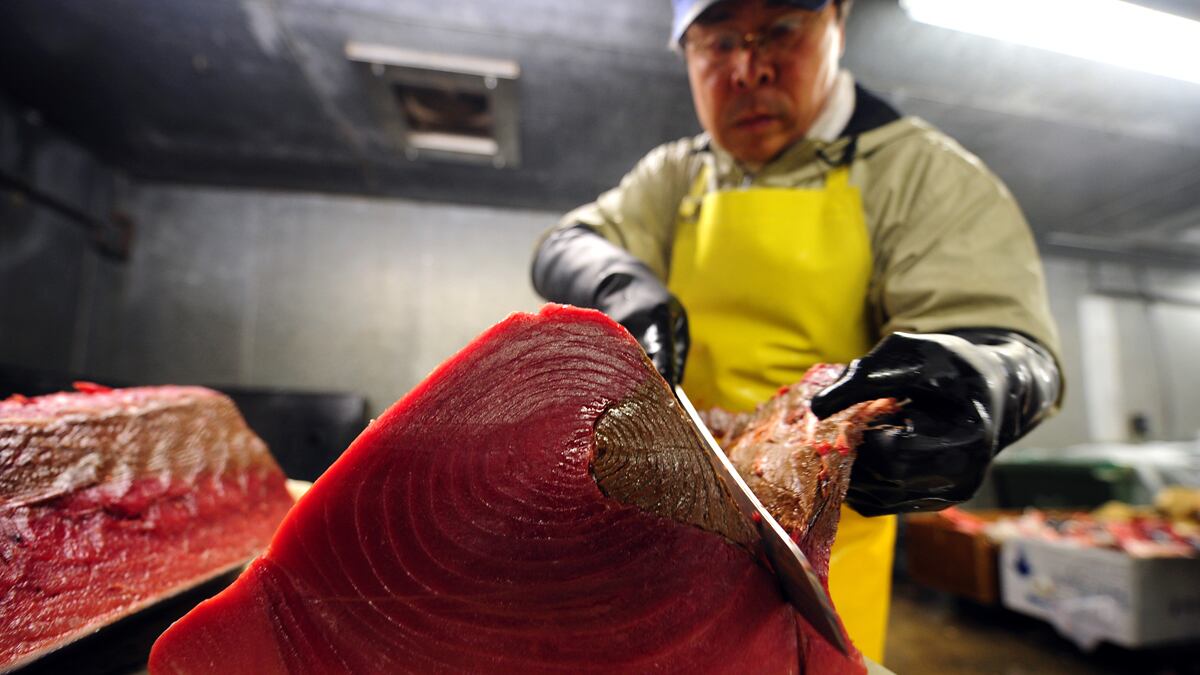It was enough to make anyone who has ever eaten seafood, especially tuna, feel a small flop in their stomach over Memorial Day weekend, when a new study from the National Academies of Science showed that radioactive tuna was showing up off the coast of California. The levels of radioactive cesium and potassium were elevated, and the source was unmistakable. Even back-of-the-envelope calculations could prove that the behemoth bluefin tuna species had come from Japanese waters after the catastrophic nuclear meltdown at Fukushima last year.
There were a lot of reasons to be instantly concerned. Radiation poisoning went through the media panic machine last year after the meltdown, and now it was back. And not just in our air or leeching into our ocean, but potentially showing up on our plate.
Yet despite the breathless hand-wringing, it turns out our food is safe. “People become terribly anxious about this subject, sometimes needlessly so,” says Nicholas Fisher, the Stony Brook University researcher behind the study.
The bluefin arriving on the shores of California won’t kill you. In fact they won’t even make you sick, according to guidelines from the Food and Drug Administration and other environmental regulators. For one thing, Americans hardly eat imperiled bluefin tuna at all. Nearly 80 percent of the world’s annual catch goes straight to Japan. The rest shows up only in the fanciest of fancy sushi restaurants. Even eating several pounds of Pacific bluefin wouldn't make you sick, reports Ken Buesseler, a radionuclide researcher with the Woods Hole Oceanographic Institution. “It’s very much not a level to be concerned about.”
And it’d set you back, too. A small piece of sashimi can easily cost $24. (Earlier this year, an 800-pound bluefin fetched nearly $750,000). But in terms of radiation, you could get there a lot faster. To the throngs of reporters covering the bluefin story, Stanford researcher Daniel Madigan has a colorful way of explaining it: you’d get more radioactive potassium from a banana than you would from a bluefin that came from Japan.
Still, FDA officials scrambled to silence the alarm. The agency doesn’t test much Bluefin, but since April 2011, government inspectors have tested all seafood imports to the U.S. that originate in or near Japanese waters. Of 1,299 samples taken, more than 99 percent have shown up clear of radiation. The other 1 percent was below “actionable” government levels.
More worrisome might be the federal government’s inspection record. Only about 2 percent of all U.S. seafood is inspected, according to a study last year from the Government Accountability Office, the investigative arm of Congress. The FDA has vowed to increase the inspection rate, but simply doesn’t have enough hands. The agency has turned its focus recently onto “preventative controls,” such as inspecting how seafood companies treat their product. But that effort ignores what might already be inside the fish before it’s caught.

Other environmental experts think the bluefin study might be more notable for its novelty, rather than its alarm. “From a pollution standpoint, it’s incredible to have a tracer on a species to see where it travels,” says Catherine Kilduff, a staff attorney with the Center for Biological Diversity. It’s highly rare to track a species knowing exactly when it left point A and arrived at point B. And the pollutants—Cesium-134 and Cesium-137—are distinct byproducts of nuclear power, which make the source contaminant simple to identify.
The larger focus might be how marine pollutants end up affecting most land-dwellers. The ocean is filled with lots of contaminants, such as plastics, oil, and extra carbon. The one that gets the least attention might be mercury. It has a lot in common with radiation. Both are produced by generating power (radiation from nuclear; mercury from coal). Both mercury and some forms of radiation bio-accumulate, meaning the toxins stay in the body and amass in larger and larger predators. That’s why tuna, near the top of the food chain, have so much. Radiation dissipates over time with every isotopic half-life. But mercury sticks around forever.
David McGuire tests Pacific seafood for mercury with GotMercury.org, a part of the Turtle Bay Restoration Network. His team has found yellowfin tuna, a species more common to American plates, to sometimes have more than 1 part per million of mercury, the federal limit set by the FDA. Bluefin species have registered up to six times higher than federal standards. It's harder to identify the source, but burning coal, which produces organic methyl mercury, is the major global factor that has increased over the past century. “That’s what we should be focused on,” he says. “We need to change our own habits if we're concerned about our health and the health of the oceans.”
Correction: An earlier version of this article stated that eating several pounds of Pacific bluefin could make someone feel sick. In fact, the threshold for illness or risk of cancer would be significantly higher and could not possibly be consumed in one sitting.





